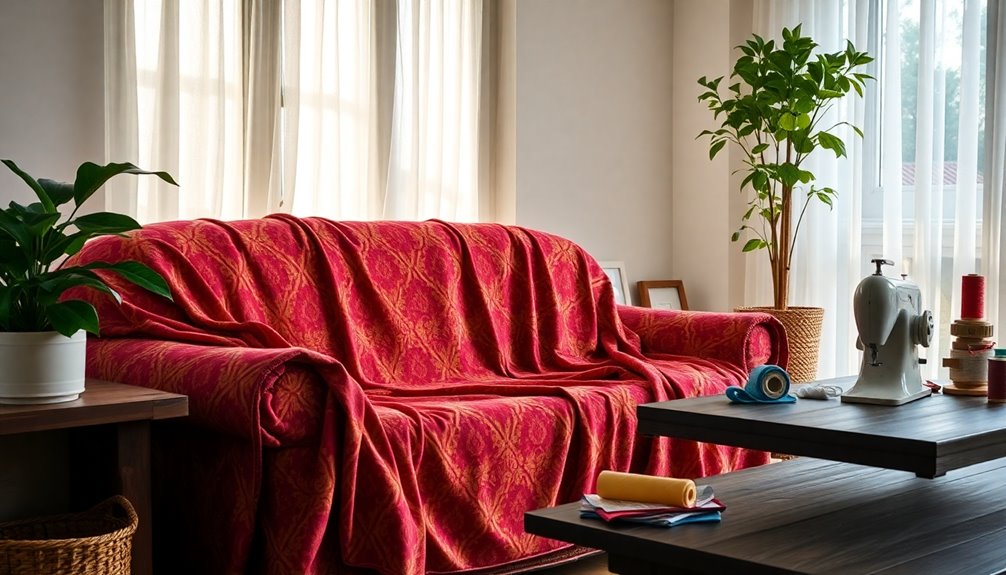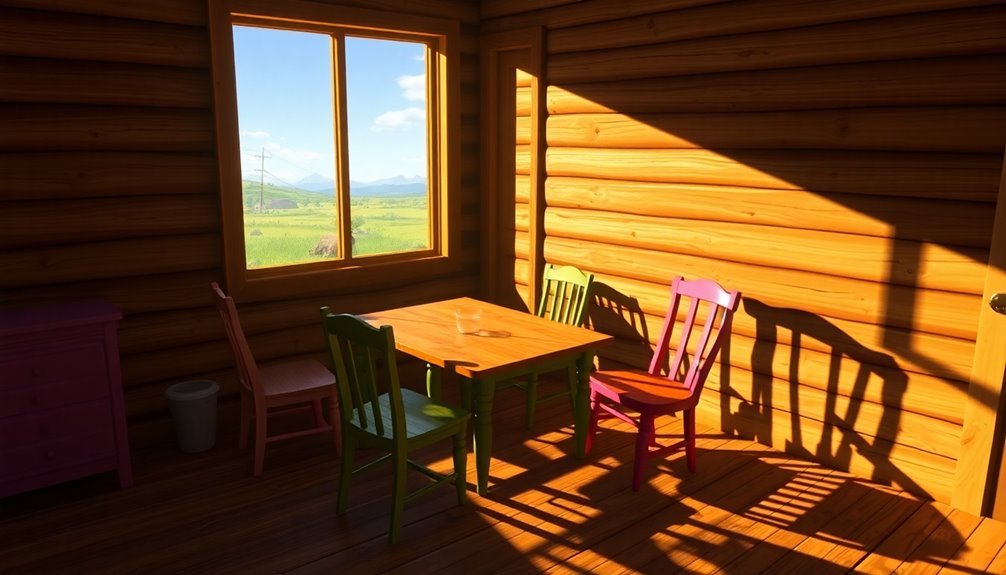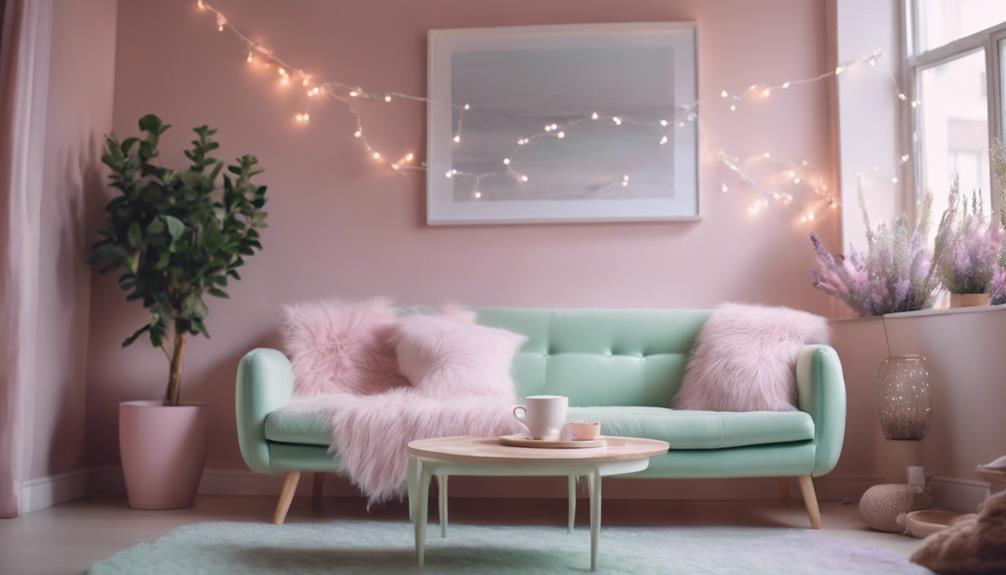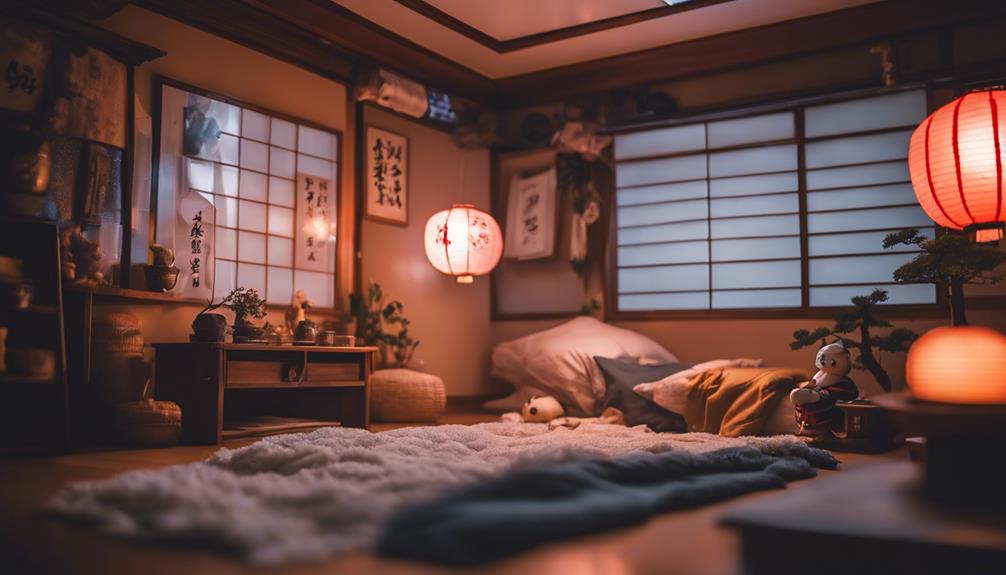Making a sofa cover is easy and can refresh your furniture’s look. Start by measuring your sofa accurately, including the arms and cushions, so you get a snug fit. Choose a durable, washable fabric like cotton or polyester. Cut the fabric pieces and use a sewing machine to stitch them together, ensuring to pin the fabric for stability. When fitting the cover, tuck any excess fabric into the crevices for a neat finish. To maintain it, consider protective measures against sunlight and pet hair. Keep going, and you’ll discover tips to enhance longevity and style! To further enhance the look of your newly made sofa cover, consider adding decorative elements like piping or a contrasting trim to give it a unique flair. Remember to keep sofa covers securely attached by using velcro or elastic bands at the corners, preventing any movement during use. Regularly check for wear and tear, and don’t hesitate to make adjustments or repairs to keep your cover looking fresh and stylish.
Key Takeaways
- Choose durable, washable materials like cotton or polyester for easy maintenance and comfort in your sofa cover.
- Accurately measure your sofa dimensions, including length, depth, height, and individual cushions to ensure a proper fit.
- Cut fabric using a large, clean area and mark cut lines with fabric chalk for precision and alignment.
- Pin fabric pieces together before sewing, maintaining consistent seam allowances for a durable finish and preventing fraying.
- Fit the cover on the sofa, making adjustments as needed and tucking excess fabric into crevices for a snug appearance.
Introduction
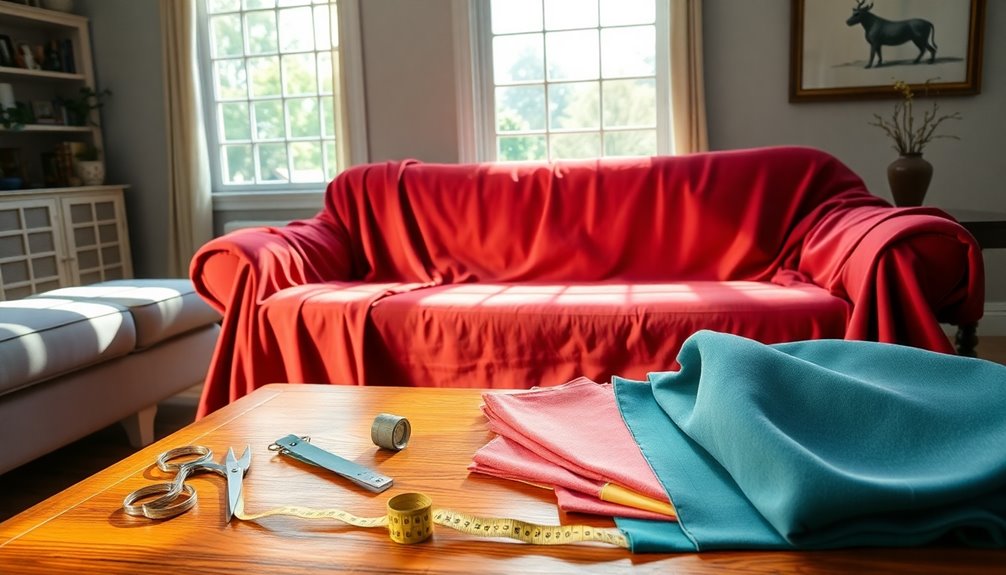
When you make a sofa cover, keeping it clean is just as important as creating it. You'll want to establish a weekly vacuuming routine and learn fabric-specific cleaning techniques to keep your sofa looking fresh. Plus, knowing how to tackle pesky red wine spills can save your cover from permanent stains. Additionally, incorporating regular cleaning and servicing into your maintenance routine can help improve the longevity of your sofa cover.
Weekly Vacuuming Routine
A well-maintained sofa not only enhances your living space but also contributes to your home's overall hygiene. Establishing a weekly vacuuming routine is essential for effectively removing dust, dirt, and pet hair from your sofa cover. This simple maintenance task helps maintain the appearance of your upholstery and keeps allergens at bay.
Use a vacuum cleaner equipped with an upholstery attachment to reach all the nooks and crannies of your fabric sofa. Focus on high-traffic areas, like the seat cushions and armrests, where dirt tends to accumulate more quickly. Don't forget to vacuum the sofa before and after washing or applying any protective treatments; this maximizes cleanliness and the effectiveness of your efforts.
Regular vacuuming not only prolongs the life of your sofa cover but also enhances indoor air quality by reducing allergens trapped in the fabric. Additionally, a clean sofa can reduce allergens that may contribute to respiratory issues, making it a crucial part of maintaining a healthy home environment. Make this routine a part of your home maintenance plan, and you'll enjoy a cleaner, healthier living environment while keeping your sofa looking its best. With just a little time each week, you can ensure your sofa remains a beautiful centerpiece in your home.
Fabric-Specific Cleaning Techniques
Maintaining a clean sofa goes beyond regular vacuuming; understanding how to care for different fabric types is key to preserving their appearance and longevity. For cotton sofa covers, machine wash them in cold water and tumble dry on low heat to prevent shrinkage while keeping them soft. Polyester covers require gentle cleaning methods; use a mild detergent and avoid bleach to maintain color and fabric integrity.
Linen covers should be hand washed or dry cleaned to avoid excessive wrinkling and to keep their natural texture intact. If your sofa has upholstery-grade fabric, spot clean using a mild soap solution and a soft cloth to tackle stains without compromising durability.
Always refer to the specific care instructions that came with your fabric. This ensures you're using optimal cleaning methods for longevity and appearance. When handling your covers, make sure they're properly fabric folded to avoid creases when storing. By following these guidelines, you'll keep your sofa covers looking fresh and inviting for years to come.
Targeting Red Wine Spills
Red wine spills can be a nightmare for your sofa cover, but quick action can save the day. When you notice a spill, grab a clean cloth and gently blot the area to absorb excess liquid. Avoid rubbing the fabric, as this can spread the stain and make cleaning harder.
For fresh wine stains, mix a solution of two parts water and one part dish soap. Apply it to the stained area and blot again with a clean cloth to lift the stain. If the stain is older or stubborn, try a DIY paste of baking soda and water. Apply this paste to the stain and let it sit for several hours before rinsing with a damp cloth.
Before using any cleaning solution, always check the manufacturer's care instructions for your specific sofa cover fabric. This precaution helps prevent damage to the material. To make future spills easier to handle, consider regularly treating your sofa cover with a fabric protector. This step helps repel stains, ensuring that when red wine spills do occur, your cleaning efforts are more effective. Additionally, regular vacuuming can help maintain the overall cleanliness of your sofa cover and prolong its lifespan.
Avoiding Sunlight Damage
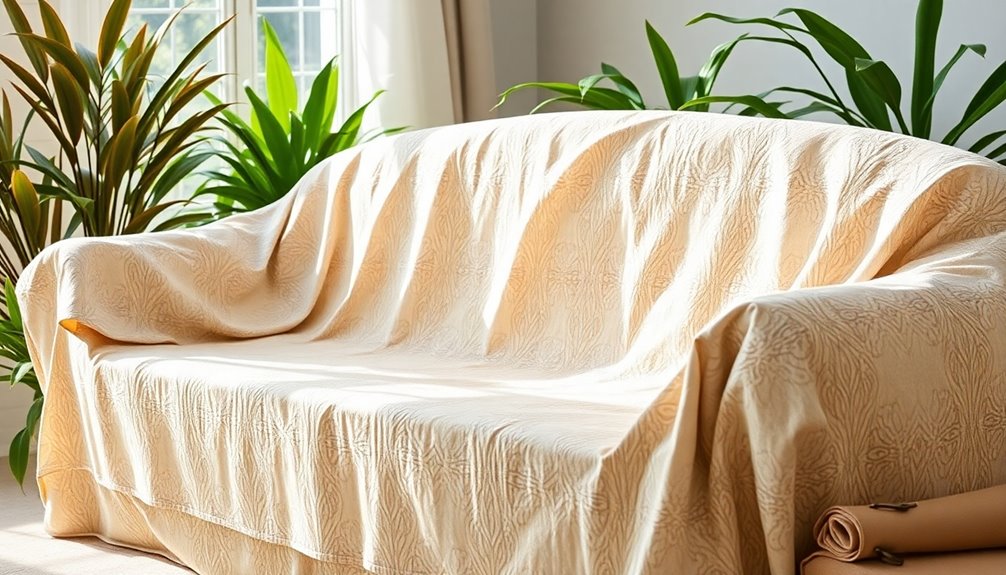
To protect your sofa cover from sunlight damage, choose durable, stain-resistant fabric that can withstand UV exposure. Layering with decorative throws not only adds style but also provides an extra barrier against fading. Reinforcing seams and edges will ensure your cover lasts longer, even in bright environments.
Using Durable, Stain-Resistant Fabric
Choosing the right fabric for your sofa cover can make all the difference in durability and maintenance. Opt for upholstery-grade fabric that's both durable and stain-resistant to handle everyday use. Fabrics with a tight weave and synthetic fibers like polyester or treated cotton not only resist stains but also minimize fading from sunlight exposure. Look for fabrics labeled as UV-resistant, ensuring your sofa cover lasts longer without unsightly sun damage.
Before you start sewing, don't forget to pre-wash and dry the fabric. This step helps remove any finishes that could hinder stain resistance and accounts for any potential shrinkage during future laundering. Regularly clean and maintain your fabric according to the care instructions to preserve its stain-resistant properties. This routine will prevent dirt and grime buildup, keeping your sofa looking its best. Additionally, consider the benefits of dual-flush toilets when thinking about maintaining cleanliness in your home, as they can help you save water and reduce utility costs.
Layering With Decorative Throws
Layering decorative throws on your sofa not only adds style but also acts as a shield against sunlight damage that can fade your upholstery over time. To maximize their protective benefits, choose throws made from UV-resistant fabrics. These will provide a better protective barrier against harmful rays while keeping the colors vibrant.
When selecting your decorative throws, consider how they complement your existing sofa cover. Aim for colors and patterns that create a cohesive look in your living space. In high-traffic areas, opt for heavier throws to protect your sofa from wear and tear. Lighter throws can add flair without excessive bulk, perfect for showcasing your style.
Don't forget to regularly rotate and wash your decorative throws. This practice not only prevents fabric wear but also ensures they remain fresh and visually appealing. By layering throws thoughtfully, you'll not only enhance your sofa's aesthetic but also extend its lifespan. Incorporating farmhouse textiles can bring an extra layer of charm to your decor. So go ahead, mix and match those throws to create a stylish, protective barrier that keeps your sofa looking great for years to come!
Reinforcing Seams and Edges
Reinforcing seams and edges is crucial for ensuring your sofa cover withstands the test of time while also minimizing sunlight damage. Start by using a zig-zag stitch or a serger to prevent fraying, especially in high-wear areas. This technique enhances durability, ensuring that your cover holds up against daily use.
Next, choose upholstery-grade thread that matches your fabric. This will not only strengthen the seams but also maintain a cohesive look. For critical seams, particularly in corners and edges, double-stitching will add even more strength, making your cover resilient against stress.
To protect against sunlight damage, consider applying a fabric sealant along the edges of your slipcover. This additional barrier helps prevent fading over time, keeping your cover looking fresh. Additionally, choosing fabrics with UV protection can further enhance your sofa cover's longevity in sunny environments.
Finally, regularly rotate and flip your cushions. This practice distributes wear evenly, reducing the risk of sun damage to any single area. By focusing on these steps, you'll significantly enhance the longevity of your sofa cover while keeping it vibrant and strong against the elements.
Upholstery Fabric Patching Techniques

When patching upholstery, you'll want to consider not just the fabric but also the structure of the sofa itself. If the frame's integrity is compromised, it can affect how well your patch holds up over time. Plus, don't overlook techniques for leather repairs and keeping your cushions fluffed for a polished look.
Frame Integrity Concerns
Before diving into patching upholstery fabric, it's crucial to ensure your sofa's frame is in solid condition. A compromised frame can seriously affect the overall stability and appearance of your upholstery, so take a moment to inspect it for any weaknesses or damage. Once you're confident in your frame integrity, you can proceed with effective patching techniques.
Choose a heavy-duty upholstery fabric that matches your existing sofa in weight and texture for a seamless integration. One popular method is "the patch and stitch." Cut a piece of fabric slightly larger than the damaged area, and stitch it securely around the edges. This technique not only covers the damage but also reinforces the area.
For a more discreet repair, consider using an iron-on fabric patch applied to the inside of the upholstery. This provides both support and a barrier against further damage, enhancing the longevity of your sofa. Remember to always test any adhesive or fabric treatment on a small, inconspicuous area first. This way, you can ensure compatibility with the original upholstery before committing to larger patching projects.
Leather Repair Techniques
Leather repair techniques require a careful approach, especially when addressing damaged areas on your sofa. Start by thoroughly cleaning the damaged area with a leather cleaner to remove any dirt and oils. This step is crucial for ensuring your leather patch adheres properly.
Next, choose a leather patch that closely matches the color and texture of your original upholstery for a seamless repair. Cut the patch to extend at least half an inch beyond the damaged area, providing enough surface for adhesion. Apply a leather adhesive or glue around the edges of the patch, then press it firmly onto the damaged area. To keep it in place while drying, use clamps or weights.
For a professional finish, once the adhesive has set, use a leather dye or colorant to blend the edges of the patch with the surrounding leather. This will help ensure the patch matches your sofa's original color and looks seamless. By following these steps, you'll restore your leather sofa's appearance and extend its life, making it look as good as new.
Cushion Fluffing Techniques
Regularly fluffing your sofa cushions can significantly enhance their appearance and comfort. Start by using your hands to plump the cushions, which helps maintain their shape and prevents uneven wear. Remember, each sofa is different; some may require more attention than others. If your cushions are sagging, consider replacing the fillers with high-density foam inserts. These provide better support and longevity compared to standard, worn-out fillers.
If you're dealing with cushion covers that need patching, ensure the extra fabric matches the original in weight and texture. This maintains a cohesive look across the whole cover. When patching, use a strong adhesive or double-sided fabric tape to secure the patch. For those with sewing skills, consider employing a slip stitch or whip stitch to achieve a nearly invisible finish, keeping the repair discreet. Additionally, regularly grooming your pets can help reduce shedding and minimize the amount of hair that settles on your sofa.
Adjusting for Pet Hair
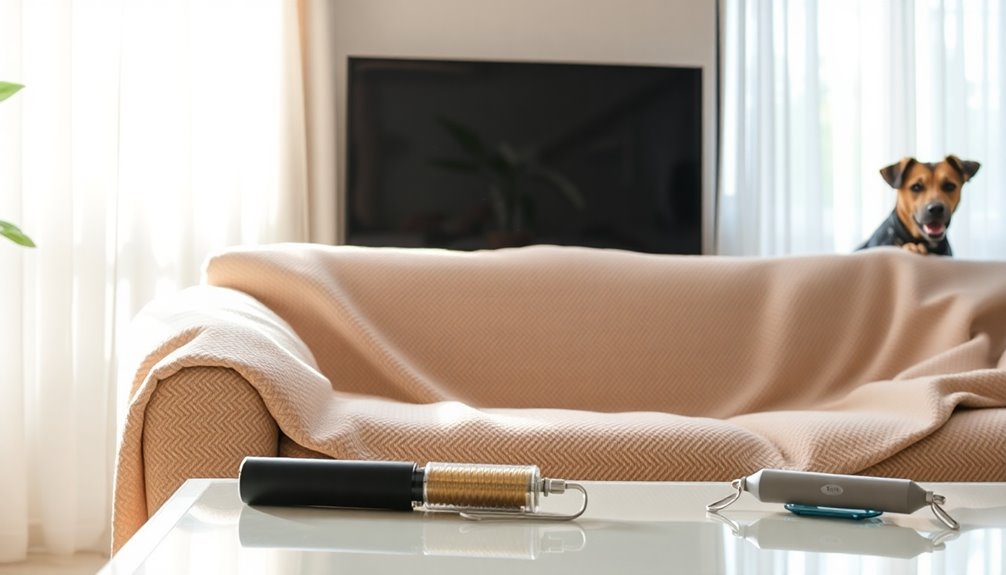
When you have pets, keeping your sofa cover free of hair can feel like a never-ending battle. To make a sofa slipcover that stands up to pet hair, choose fabrics with a tighter weave, like canvas or microfiber. These materials are less likely to trap hair compared to looser weaves.
Regular vacuuming is essential. Use a vacuum with a pet hair attachment to effectively remove hair and dander before it embeds into the fabric. For added protection, consider incorporating a protective layer, such as a washable throw blanket or a pet-specific cover. This not only catches hair but also makes washing easier.
In addition to vacuuming, you can use a lint roller or rubber gloves dampened with water to gather and remove pet hair quickly. These tools are great for those quick clean-ups when guests are on their way.
Lastly, always select slipcovers that are machine washable. This ensures that keeping your sofa hair-free is convenient and hassle-free, allowing you to enjoy your time with your furry friends without the worry of constant cleaning. Additionally, regular inspections of your slipcover can help prevent issues such as bed bug infestations, ensuring a comfortable and safe environment for both you and your pets.
Seasonal Storage Solutions

Storing your seasonal sofa covers properly can make all the difference in maintaining their quality and appearance. One effective storage solution is using vacuum-sealed bags, which can reduce the space needed by up to 75%. These bags help protect your fabric from moisture and dust, keeping your covers in pristine condition.
Alternatively, breathable fabric storage bins are a great option to prevent mildew while maintaining the integrity of your sofa covers. Make sure to label your storage containers clearly with the season and contents, making it easy to find what you need during seasonal transitions.
When it comes to storing your covers, consider rolling them instead of folding to minimize creasing and help maintain that crisp appearance when you put them back on your sofa. Additionally, always aim to store your seasonal sofa covers in a climate-controlled environment. This protects against extreme temperatures and humidity, which can damage the fabric fibers over time. By using these seasonal storage solutions, you can ensure your sofa covers stay fresh and ready for use whenever you need them.
Conclusion
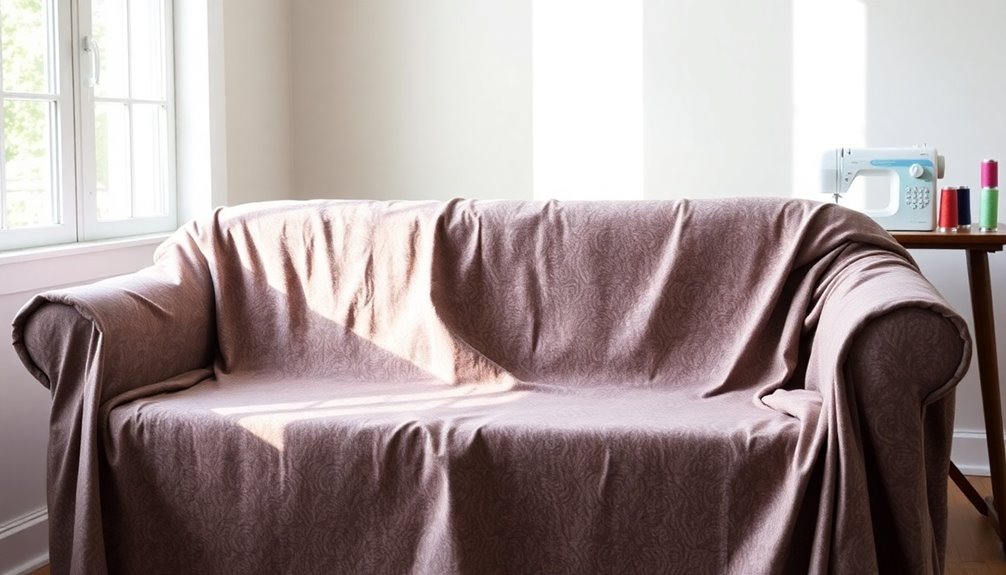
Creating your own sofa cover can be an incredibly satisfying project that not only revitalizes your furniture but also saves you money. By opting for a DIY sofa cover, you can personalize your living space while avoiding the costs of professional reupholstery. To ensure your slipcover fits perfectly, accurate measurements are crucial; take the time to measure each cushion and sofa section individually. This will help minimize fabric waste and lead to a more polished final product.
When selecting fabric, choose durable fabrics like canvas or upholstery-grade materials to guarantee longevity and withstand everyday use. Solid colors can simplify the matching process during sewing, making it easier to create a cohesive look. Don't forget to consider incorporating a pattern that reflects your style!
Adding zippers and piping can enhance both the functionality and aesthetic appeal of your slipcover, allowing for easy removal and maintenance. With numerous resources available, even beginners can successfully tackle this rewarding project. So gather your materials, take your measurements, and enjoy the process of creating a stylish and practical sofa cover that brings new life to your furniture!
Frequently Asked Questions
How Can I Cover My Couch Without a Couch Cover?
If you want to cover your couch without a traditional couch cover, consider using king-sized sheets for an affordable option. You could also drape patterned blankets or throws for a quick style update. For a more customized look, try making DIY slipcovers from durable materials like canvas. Alternatively, use furniture throws that you can easily wrap and secure with ties or Velcro. This way, you'll refresh your couch without any permanent changes!
How to Reupholster a Couch Without Sewing?
To reupholster your couch without sewing, pick a durable fabric like canvas or upholstery-grade material. Measure and cut large pieces, allowing excess for edges. Use fabric glue or a staple gun to secure the fabric tightly, avoiding wrinkles. For clean seams, try iron-on hem tape. You can also add decorative elements like upholstery tacks or trim to cover raw edges and enhance the look of your newly upholstered couch.
Can You Use a Bed Sheet as a Couch Cover?
Yes, you can definitely use a bed sheet as a couch cover! It's a quick and budget-friendly solution to protect your furniture and update its look. A king-sized sheet works great for larger sofas, allowing you to drape it easily. You might prefer a fitted sheet to keep it secure or a flat sheet for a more layered appearance. Plus, most sheets are machine washable, making maintenance a breeze!
How to Turn a Blanket Into a Couch Cover?
To turn a blanket into a couch cover, start by choosing a large, durable blanket that fits your style. Measure your couch to ensure you've got enough fabric. Drape the blanket over the couch, making sure it covers all surfaces completely. Tuck any excess fabric into the crevices for a neat look. If you want a more secure fit, use safety pins or fabric clips. Finish off with decorative pillows for added flair.
